|

by Gary W. Kronk
Analysis by Seiichi
Yoshida
from
Cometography.com Website
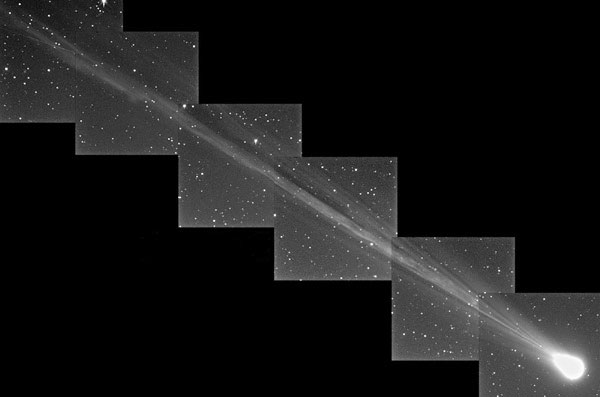
This image was
obtained by Rolando Ligustri and Lucio Furlanetto
using a 350/1750
Newtonian reflector and an ST9E CCD camera on 2003 January 29.73.
It is a combination
of six images exposed to reveal the complexity of the tail.
Discovery
S. H. Pravdo (Jet
Propulsion Laboratory) announced that the 1.2-m Schmidt telescope at
Haleakala had found a comet on 2002 November 6.60 in the course of
the Near Earth Asteroid Tracking (NEAT) program. It exhibited a tail
extending 10 arcsec toward PA 225°. With additional images on
November 6.61 and November 6.62, the magnitude was estimated as
between 17.1 and 17.5. The comet was confirmed by M. Blasco and
S.
Sanchez (Mallorca) on November 6.83 using the 0.40-m Schmidt
telescope. They noted the coma was 15 arcsec across.
Historical Highlights
-
The first orbit was
published by Brian G. Marsden of the
Central Bureau for
Astronomical Telegrams on 2002 November 7 (MPEC 2002-V31 and
IAUC 8011). Using 39 positions from November 6 and 7, he
calculated a parabolic orbit with a perihelion date of 2003
February 18.59 and a perihelion distance of 0.0999 AU (AU
=
Astronomical Unit). Marsden
confirmed the general correctness of the orbit on November 8 (MPEC
2002-V41) when 54 positions from November 6 to 8 revealed a
perihelion date of 2003 Feb. 17.72 and a perihelion distance of
0.0987 AU. After more positions became available, the perihelion
date was firmly established as February 18.30, the perihelion
distance was given as 0.0993 AU, and the orbital period was
about 37 thousand years. The orbit indicates the comet passed
closest to Earth on December 24 (0.80 AU) and will be situated
5.7° from the sun around the time of perihelion.
-
Total magnitude
estimates of this comet have been somewhat discordant during
December, with the size of the telescope being a major factor.
As the month began, most visual magnitude estimates were within
the range of 12 to 12.5. The comet brightened to between 11 and
11.5 by December 8 and was between 10 and 10.5 by the 14th.
Moonlight blocked the comet from view between December 15 and
21. Numerous observers began switching to large binoculars after
December 22, at which time magnitude estimates became more
consistent. The total visual magnitude was between 9.0 and 9.5
around the 24th and between 8.0 and 8.5 around the 29th.
-
Using observations
obtained by the German comet section up to December 26, Andreas Kammerer analyzed the brightness trend of this comet and has
stated that the rapid increase in brightness "is typical of a
small nucleus." Although he said the trend indicates a possible
maximum brightness of magnitude -15 at the time of perihelion in
February, he predicted the following on December 27: "During the
first period (which I expect will end during the next two weeks)
the brightness increases rapidly. Thereafter the increase will
noticeably slow down and come to an end, followed by a rapid
decline due to the disintegration of the nucleus." On December
23, John Bortle had wrote, "No comet as intrinsically faint as
2002V1 is presently thought to be has survived through a
perihelion distance of 0.1 AU." In other words, it seems
unlikely that this comet will survive long enough to become an
impressive daylight object in February.
-
Observations during
the first half of January were mostly affected by moonlight,
with the moon passing just 12° from the comet on the 9th. On
January 1 and 2, most observers reported magnitudes ranging from
7.6 to 8.6 and coma diameter estimates ranging from 6 to 12
arcmin. On the 14th and 15th, most observers reported magnitudes
ranging from 6.8 to 7.5 and coma diameter estimates ranging from
5 to 12 arcmin. Occasional reports of a tail were received
throughout this period. Taking the magnitude estimates of
experienced observers, the comet appears to have continued to
rapidly brightening throughout this period. The publication of a
new orbit on January 15, indicates the comet is moving in a
long-period orbit with a period of about 37 thousand years. This
indicates this small comet has survived passages through
perihelion in the past, and makes a breakup seem a little less
likely.
-
Several interesting
announcements were made during the second half of January. Pepe
Manteca (Spain) obtained CCD images on the 17th which revealed
an apparent tail disconnection event. The first naked-eye
observation was reported by Michael Jäger (Austria) on January
20. He then gave the magnitude as 6.3. Jäger obtained a
photograph that same evening which revealed a gas tail extending
2.5°. On the 23rd, an analysis by Seiichi Yoshida (Japan)
indicated the comet had slowed in its rate of brightening, with
the change having occurred around January 9.
-
The comet's changed
rate of brightening appeared to slow again beginning around
February 3, as observers were reporting brightness estimates
below the predicted values. Observers were then generally giving
the magnitude as 5, while the degree of condensation was between
7 and 8. Visual estimates of the tail length were generally
between 1° and 2°, with extreme estimates near 6°. As the
comet's angular distance from the sun continued to decrease,
many observers began losing the comet in evening twilight, but
observations resumed for many observers on February 7 and 8 with
the report of an outburst in brightness. Although magnitude
estimates are very difficult to make when comets are in strong
twilight, many observers were indicated the outburst amounted to
0.5 to 1 magnitude, which place the brightness between 4 and
4.5. Further magnitude estimates placed the comet at 3.5 on the
10th, 3.0 on the 12th, and about 2.0 very late on the 13th.
-
The comet entered
the field of view of the Solar & Heliospheric Observatory (SOHO)
on February 16.
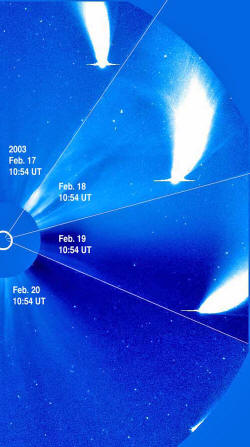
(click image to enlarge)
This image is
a collage of four images obtained by the
Solar & Heliospheric
Observatory (SOHO) at 10:54 UT on 2003 February 17, 18, 19, and 20.
The white circle near
the center of the left margin represents the outline of the sun.
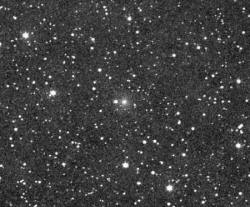
(click image to enlarge)
This
photograph was obtained by Michael Jäger on 2002 December 1.80.
It is a 9.5-minute
exposure obtained with a 200/300 Schmidt camera and Kodak TP2415
hypered film.

This image was
obtained by G. Sostero on 2002 December 10.99.
The image is composed
of 10 120-second exposures obtained
with a 0.3m f/2.8
Baker-Schmidt camera and a CCD camera..
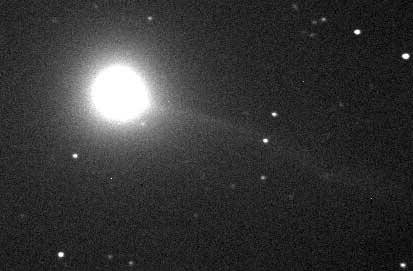
This image was
obtained by Pepe Manteca on 2003 January 17.
There is a knot of
material located two-thirds of the way down the tail from the coma,
which may be a tail
disconnection event.
Click image to see
animation.
Additional images and
movies of this comet can be found at
Manteca's web site.
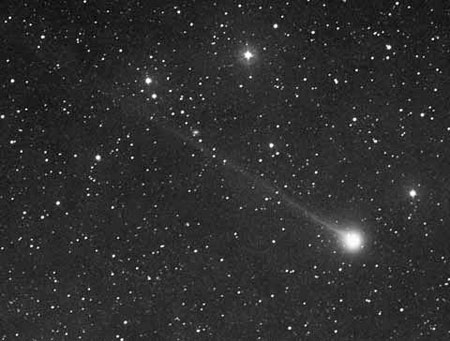
This photograph was obtained by Michael Jäger on 2003 January 20.72.
It is a combination of two 7-minute exposures obtained
with a
200/300 Schmidt camera and Kodak TP hypered film.
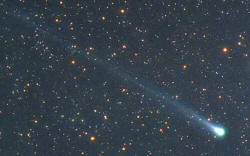
(click image to enlarge)
This photograph was obtained by Michael Jäger using a
200/300
Schmidt camera on 2003 January 28.74.
It is a combination of two
6-minute exposures obtained with Kodak Ektachrome 100S
and one
7-minute exposure obtained with Kodak TP.
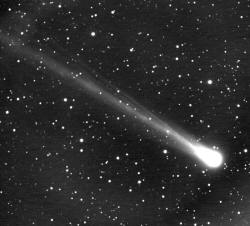
(click image to enlarge)
This image was obtained by high school students at Amtsgymnasiet and
EUC Syd (Sonderborg, Denmark) on 2003 January 31.73.
The students
were Soren V. Andersen, David Lange, Martin Sorensen, Kristian
Mandrup,
and Michael Jensen. It is a composite of 43 50-second
exposures obtained with a telescope and a CCD camera.
Other images
of the comet obtained by this class are located on
their webpage
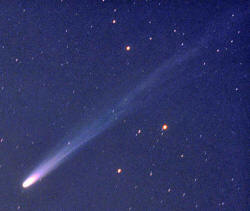
(click image to enlarge)
This photograph was obtained by Michael Jäger using a 250/450
Schmidt camera on 2003 February 9.74.
It is a combination of two
1-minute exposures obtained with Kodak Ektachrome 100S
and two
5-minute exposures obtained with Kodak TP.
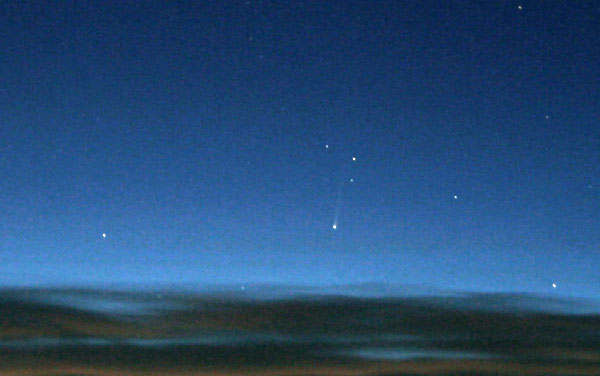
This image was obtained by Ginger Mayfield (Colorado) on 2003
February 10.
It is an unguided 8-second exposure obtained with a
Canon D60 digital SLR on a tripod.
The outside temperature was then
-3° F.
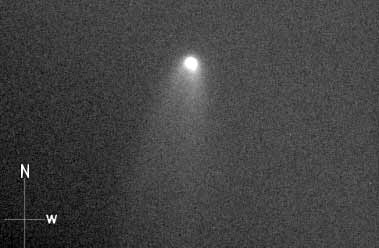
This image was obtained by V. Buso and L. A. Mansilla
(Observatorio
astronómico Cristo Rey, Rosario, Argentina) on 2003 February 24.98.
It is a 3-second exposure obtained with an 11-inch Celestron and KAF
0400 CCD camera.
The comet's magnitude was then estimated as 2.5.
|










